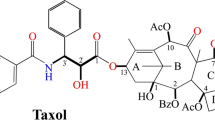A Periconia sp was isolated from Torreya grandifolia (a relative of yew that does not synthesize taxol) near Huangshan National Park in the People’s Republic of China. This fungus, not previously known as a tree endophyte, was isolated from the inner bark of a small lower limb. When freshly isolated from the tree and placed in a semi-synthetic medium, the fungus produced readily detectable quantities of the anticancer drug taxol. Other taxol-producing endophytes were also isolated from this source. The production of taxol by Periconia sp was demonstrated unequivocally via spectroscopic and immunological methods. However, successive transfers of the fungus in semi-synthetic medium resulted in gradual attenuation until low production occurred even though fungal growth was relatively unaffected. Several compounds, known previously as activators of microbial metabolism, including serinol, p-hydroxybenzoic acid, and a mixture of phenolic acids, were capable of fully or partially restoring taxol production to otherwise taxol-attenuated cultures. The compound with the most impressive ability to activate taxol production was benzoic acid at 0.01 mM. Benzoic acid was not a taxol precursor.
Similar content being viewed by others
Author information
Authors and Affiliations
Additional information
Received 19 December 1997/ Accepted in revised form 19 February 1998
Rights and permissions
About this article
Cite this article
Li, J., Sidhu, R., Ford, E. et al. The induction of taxol production in the endophytic fungus—Periconia sp from Torreya grandifolia . J Ind Microbiol Biotech 20, 259–264 (1998). https://doi.org/10.1038/sj.jim.2900521
Issue Date:
DOI: https://doi.org/10.1038/sj.jim.2900521




